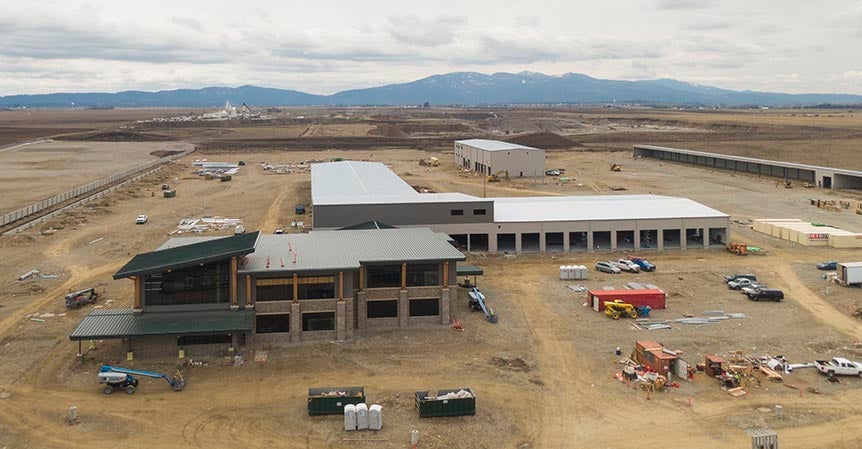 After more than three years of planning, development and construction, we are excited to now serve our members from our new location in Rathdrum. KEC was previously headquartered in Hayden for more than 40 years and since that time, our cooperative has grown by over 25,000 members and nearly 100 employees. Construction of the new facility was necessary to accommodate the growth our cooperative has experienced and will serve our needs for the next 40 years.
After more than three years of planning, development and construction, we are excited to now serve our members from our new location in Rathdrum. KEC was previously headquartered in Hayden for more than 40 years and since that time, our cooperative has grown by over 25,000 members and nearly 100 employees. Construction of the new facility was necessary to accommodate the growth our cooperative has experienced and will serve our needs for the next 40 years.
Our new headquarters is located on a 44-acre site in Rathdrum on Lancaster Road between Highway 41 and Greensferry Road. The property is nearly three times the size of our previous property, which allowed us to build a facility with approximately 180,000 square feet of space under roof, mostly for vehicles, equipment and materials storage. The facility is laid out such that growth beyond that can be accommodated by expanding administrative office space, warehousing, fleet parking and our materials storage yard as future growth occurs.
Facility Master Planning
Our journey with facility master planning began in 2020 when it became clear we were running out of space in our Hayden headquarters and lacked the capacity to further grow. KEC hired a consultant to conduct a facility master plan, which assessed our current and future needs in terms of land and building space. It also evaluated a number of alternatives available to the cooperative.
The most viable alternative was to purchase 40 to 45 acres of land for the construction of a new headquarters and to sell our Hayden facility. Fortunately, we were able to find and purchase property in Rathdrum that met our needs. Next, we sold the Hayden headquarters to Kootenai County at market value. That sale closed in December 2020. As part of the deal, KEC had the right to continue operating from it rent-free for three years. Construction of the Rathdrum headquarters began in the spring 2022 and was completed in October 2023.
Check out the time lapse video of construction below. If you have any questions, please contact us.
Past Newsletter Articles About the HQ
This feature is about KEC's crews, the equipment they use to do their jobs and how our new headquarters was designed to support their operations.
KEC has two types of line crews. The first of these is a “heavy crew” that is made up of a foreman, three journeyman linemen and an equipment operator. Each of these crews has a digger/derrick, a large bucket truck, a small bucket truck and a backhoe with a trailer. These crews are capable of tackling nearly any project the cooperative can throw at them. They are also very flexible. When working on large jobs, multiple crews can be assigned to a project. When working on smaller jobs, a heavy crew can be split into smaller crews.
The second type of crew KEC operates is called a “make permanent” crew. These crews focus on converting temporary services used during home construction to the permanent service after construction is completed. Each of these crews is comprised of a lead lineman, a journeyman lineman and an equipment operator. They are equipped with a small bucket truck, a flatbed truck, a mini excavator and an equipment trailer. Learn more about their work in the Employee Spotlight article about Lead Lineman Chad Hall.
In addition to these crews, KEC also employs a few other journeyman linemen who are assigned to specialized work, such as system inspections, equipment repair and substation service. During outages or other emergency work, these linemen are integrated with our other crews to provide additional flexibility of operations.
The vehicles used for linework are very expensive. The equipment used by each heavy crew costs over $1 million. That equipment must also be ready for use at all times. If parked outdoors, crews must spend valuable time clearing snow off their vehicles during the winter months. During the summer months, the additional UV exposure increases the maintenance required on vehicles reducing their operational availability. For these reasons, digger/derricks and line trucks need to be stored indoors while backhoes and excavators, along with their trailers, need to be stored under awnings. Our previous headquarters had 18 bays for indoor vehicle storage, and we had 29 vehicles that had to be parked there!
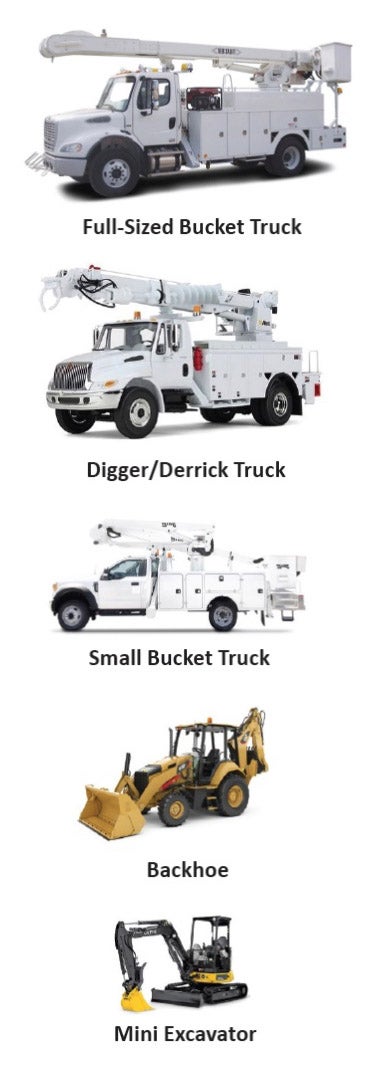
The photo below shows what that the indoor parking at our new Rathdrum HQ looks like.
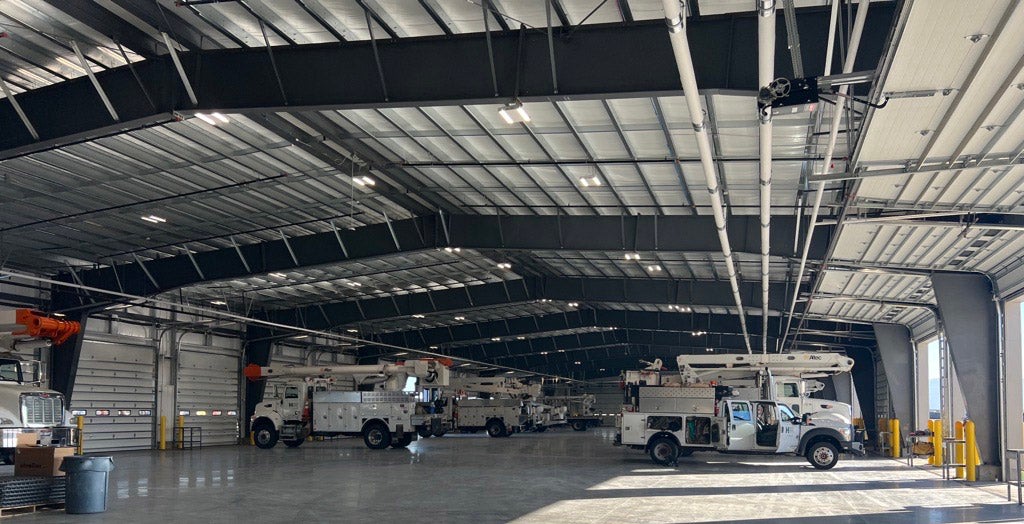
KEC’s previous electro technician space wasn’t large enough to maintain some of the larger equipment we are installing on our system due to increased growth and capacity in our area. The new space was designed with efficiency and safety in mind, allowing room for an overhead crane to lift large and heavy equipment, such as regulators, switchgear, pad mount transformers and reclosers. This equipment can be removed from its location in the field with a boom truck and moved into the shop with a forklift. From there the trolley crane can move the equipment vertically and horizontally so the electro technicians can safely perform internal inspections, repairs, or get equipment configuration and testing complete for a new project.
In addition, the new electro technician shop space can support KEC’s System Inspection and Maintenance program more efficiently as significantly more time is spent focused on inspecting specialty equipment and conducting condition assessments. This program helps ensure our cooperative’s infrastructure continues to be well-maintained and service reliability continues to be enhanced.
A new hybrid space, called the engineering lab, is adjacent to the electro technician offices and shop and is used by the electro technicians and the electrical engineers. In this space, staff conduct meter testing and configure and test reclosers and regulator controls. New and emerging technologies and KEC’s focus on integrating our new supervisory control and data acquisition (SCADA) system means we must have the ability to properly configure and test new devices before they are installed on our system.
The new headquarters also provides more storage areas for meters, instrument transformers, and specialty equipment parts. Previously, these were stored in several places across KEC’s Hayden campus, including outdoor temporary storage containers. Equipment is better organized with more space, providing a more efficient way to handle material, do testing and get it configured and ready for installation.
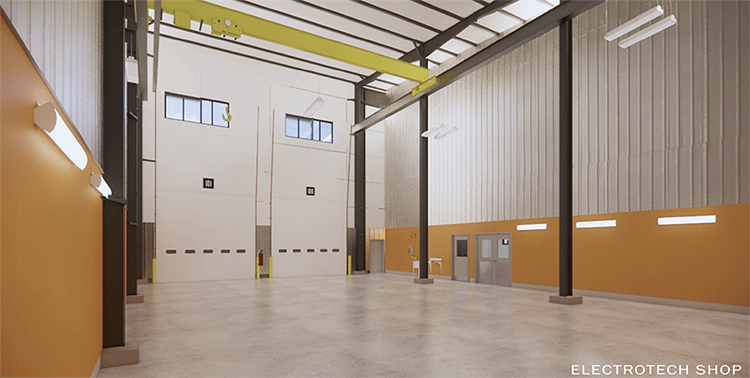
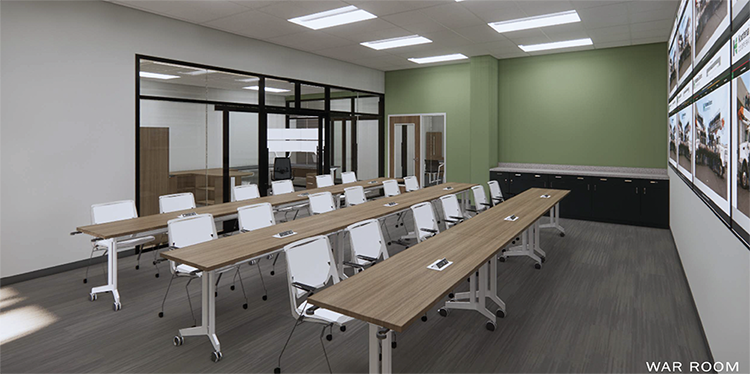
You might be asking yourself: what is a war room? A war room is a large conference room or collaborative space focused on keeping the lights on and used for emergency response. In KEC’s case, this high technology space is central to KEC’s engineering and operations department. Four TV screens in the war room display real-time SCADA data 24/7. The other four screens can display KEC’s outage management system or be used for video conferencing. The war room is large enough to also be used for cross department meetings when not in use for emergency response.
As mentioned in the Employee Spotlight article about V.P. of Engineering and Technical Services, Scott Davis, KEC has been working on the installation and deployment of a new SCADA system. We previously did not have a SCADA control center and one of our goals with the new headquarters was to have a space for SCADA operators from which to control the system. The SCADA control center also has a glass wall that can open up to the war room when involvement of other KEC staff is needed.
When outages occur, our goal is always to restore power as quickly and safely as possible. As our substations and field devices communicate with the new headquarters, SCADA will provide the operators the status of feeder breakers and other devices. This means our SCADA operators will know what major devices operated during an outage so they can more quickly isolate problem areas, perform switching on the system, and restore power to as many members as possible until necessary repairs are made. The control center is also used to remotely monitor our substations and equipment loading levels, voltages and power factor to increase system operating efficiencies.

Now we’d like to feature the maintenance facility, which is a separate building from the administrative offices, warehouse and covered parking for KEC-owned vehicles. The maintenance facility includes separate bays for mechanics, welding and vehicle washing.
As KEC has grown, so has our fleet and the need to maintain all of our vehicles. We keep and maintain our trucks and vehicles as long as possible. KEC had long outgrown our previous maintenance facility and the new one was designed with space and efficiency in mind. The new facility has four drive-through bays (or eight total bays) for mechanics as well as a welding bay, which is six more bays than our previous facility. These additional bays allow KEC mechanics to work on more than one vehicle at a time, reducing the time vehicles are in for repairs so we can get them on the road faster.
The new space is also large enough for a crane, which allows our mechanics to safely do more vehicle maintenance and fabrication in-house. Conducting as much maintenance as possible in-house saves time and money. It allows us to do the work exactly how we need it done and this is a significant cost benefit to the cooperative.
Winters in North Idaho are beautiful, but the snow and ice on the roads create maintenance challenges. To help, highway districts in our area spray de-icer on our roads. It’s effective at keeping the road ice-free, but is also extremely corrosive to metal and plastics. This is especially a problem on the undercarriage of vehicles, and leads to rust and damage to axles, wires, nuts, brake systems, ball joints and more. The best defense against rust from de-icer is routine undercarriage washing. That’s why a wash bay is another important part of our new maintenance facility. Previously, we had a contractor come to our Hayden office on the weekends to wash our vehicles. This was an expensive service and not as effective as the undercarriage wash system at our new maintenance facility. The system washes the undercarriage of trucks and small equipment as they drive over it to help remove mud, de-icer and grime build-up (check out the photo below for an example of how it works). There is also a wash wand on each side of the car wash so crews can spray off the vehicles when they finish their day. The goal is to keep our vehicles rust-free, which will decrease costs and maintenance, and increase the life of our vehicles. 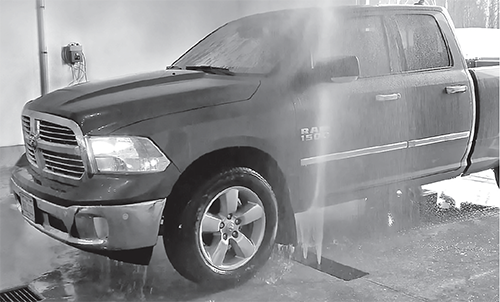
The materials storage areas include the warehouse and outdoor materials storage. As mentioned previously, space was a challenge at KEC’s Hayden facility. We stored materials in the warehouse, at our formerly owned property across the street, in shipping containers and outside. The new facility has a larger warehouse with taller ceilings to allow for more shelving that will be rated for more weight. The warehouse building is attached to the main administrative building and was constructed with future additions in mind.
The climate control in the warehouse will be improved as well. Previously, the bay doors are open in the morning and afternoon as the crews are loading and unloading their materials. The employees working in the warehouse wear coats, hats and gloves to stay warm in the winter. The new facility was designed so the warehouse is separate from the enclosed vehicle parking bays and the pull through truck bays, which will help keep the elements out of the building.
At our Hayden location, we stored much of our materials in the yard around the warehouse, which were not covered or paved. At the Rathdrum headquarters the yard is paved and most of the materials stored in the yard are covered. When we receive new shipments, they are staged, starting in storage outside and then moved into the warehouse.
We also now have a covered loading dock for deliveries which will improve safety and efficiency. The covered dock reduces the chance of employees and the forklift slipping on snow or ice.
KEC’s Hayden headquarters had a large concrete loading area where KEC crews park the trucks to be loaded with materials for the day. That set up did not allow for loading on the side of trucks. The new facility has pull through truck bays where trucks can pull in and a forklift can drive through and load materials on the sides, which will improve efficiency. This approach is less expensive to build than the large concrete loading area we had in our Hayden facility.
Lastly, KEC’s previous power pole storage yard was located across Dakota Ave. In the current facility, the pole yard is close to the warehouse and the drive through truck bays. Our goal is to extend the life of our equipment and materials and improve efficiency in the warehouse and covered storage area, which equates to quicker outage response times and reduces the cost of repair to benefit our members.

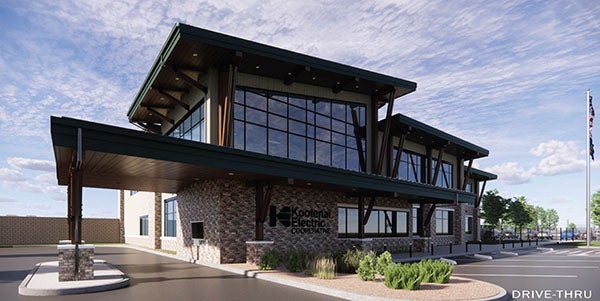
Next, we’d like to feature the drive thru and lobby areas where we provide our members service.
The member services area at our Hayden headquarters had been remodeled a few times since it was constructed in the 1990s. While these remodels improved functionality for some time, the space limitations and our growth made the new headquarters a necessity.
As we planned the new space, we made sure that things that worked well at our Hayden location were incorporated into the new design. Some of those elements included a small meeting space for staff and members, a waiting area for visitors, and lobby-facing workstations where staff can assist members. We also took the opportunity to make improvements including a larger reception desk to help two members at a time, better flow for foot traffic, enhanced safety and security features, and the addition of a drive-thru.
The new drive thru houses a payment drop-box for after-hours payments as well as a drive-up window that is staffed during regular business hours. At the window, members are able to complete quick transactions like payments and paperwork drop-off/pick-up all from the comfort of their vehicle. This is particularly convenient in times of harsh weather or for members with mobility challenges.
As we live our mission of providing exceptional service, we are always looking for ways to meet our members where they are—whether they’d like to come into the office, call us, use our SmartHub app or use the drive thru. This is just another way we are looking out for you, our members.
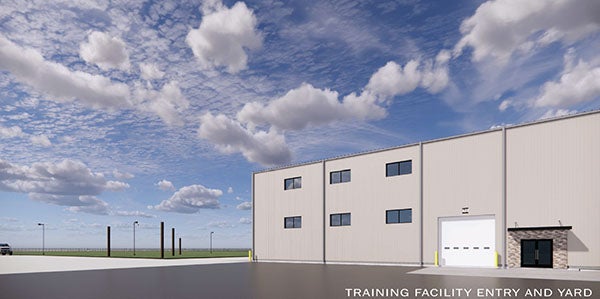
Finally, we’d like to feature the new training facility at our headquarters. The growth in our area has increased our workload and that means we need more lineworkers. It can be a challenge to find qualified lineworkers and there are few training opportunities for this trade in the Northwest. During the design process of our new headquarters, we considered the development of an indoor training facility and began collaborating with the North Idaho College Workforce Training Center, NW Line Joint Apprenticeship and Training Committee, and neighboring cooperatives, municipal and public utilities.
The KEC training facility emerged as a best practice from those discussions and will allow us to train our apprentices right here in our community, with both an indoor and outdoor training area. The indoor portion will be about 8,000 square feet and 43 feet tall, which provides the necessary space for our line workers to set power poles inside and to pull bucket trucks into the facility to work next to the poles. The design allows for flexibility and updates so our lineworkers can test new and emerging technologies in a controlled environment rather than putting it in the field first, which improves reliability for our members. A huge benefit of the indoor training facility is that it allows apprentices and lineworkers to train safely regardless of weather, season changes and or daylight to better prepare for work in less favorable conditions.
Common Questions
Simply put, we were out of space at our Hayden location and the cooperative continues to grow rapidly. Our growing ranks and the fleet of vehicles used to serve our members were straining our previous facility. A third-party professional study of our long-term needs placed our property requirements at more than twice our Hayden facility size. Below are some of the specific growing pains we must overcome in the immediate future.
- KEC has a fleet of more than 100 vehicles. Our Hayden facility did not have enough enclosed or covered vehicle storage for a fleet of this size. This forced a portion of our fleet to be parked outside in the elements, which shortens the overall life of the vehicles and can increase our response time during outages. We needed another nine truck bays (or nearly double our Hayden space) to adequately serve our membership. It may seem more logical to park these vehicles outside, but when you consider that an average line truck costs well over $100,000 and the price of a digger derrick (a truck with a long boom and a drilling/digging bit on top) can top $400,000, it’s clear KEC needs to protect these assets to ensure they can serve the membership for as long as possible.
- KEC’s previous mechanics’ bay was too small to effectively support, maintain and repair a fleet our size.
- Traffic flow in and out of our Hayden facility was inefficient for the size of our fleet as well as for large equipment deliveries. Road restrictions imposed by highway jurisdictions and roundabouts planned near our former headquarters further impede our operations.
- We had outgrown our material warehouse which needed to be expanded by about 30%.
- KEC’s Hayden location's outdoor space was limited and didn’t allow for adequate onsite material storage.
- Due to our growing workforce, the space our crews needed to meet daily and complete required safety sessions was no longer adequate and needed be increased to accommodate growth.
- Interior office space had reached maximum capacity. There were no available offices to accommodate new employees, even considering work from home opportunities.
- Space required for storage and IT equipment was largely undersized and could not be expanded without eliminating offices.
Our Hayden headquarters facility sat on about 15 acres of land divided by Dakota Avenue in Hayden. This division caused some logistical and safety challenges, as it required a steady flow of both foot and vehicle traffic between sites on an increasingly busy road. While some of our constraints at the time could be corrected through a major building remodel on that site, it would not be efficient or effective in the long term. Additionally, there were some challenges that were location specific:
- Road configurations and traffic restrictions made it extremely difficult for materials and equipment to be delivered to our Hayden headquarters and for our own trucks to leave our site. Annual spring road restrictions further exacerbated these problems.
- Due to the proximity of our location to the airport, the cooperative was subject to significant building restrictions, thus constraining our ability to remodel the facility or construct additional vehicle storage.
Our previous headquarters located in Hayden was built in the late ‘70s and had been incrementally expanded as needs arose. Additions were constructed in 1994, 2004 and 2015, but that potential had been exhausted. The site across the street from our headquarters was purchased to use for pole, transformer, machinery and other equipment storage. In order to provide a safe and efficient facility to serve our members and in which our employees can work effectively, the Hayden building would need to be expanded beyond what the site could accommodate. All things considered, was determined to be more cost-effective to construct a new building that meets our needs now and into the future than to further renovate and expand the previous one.
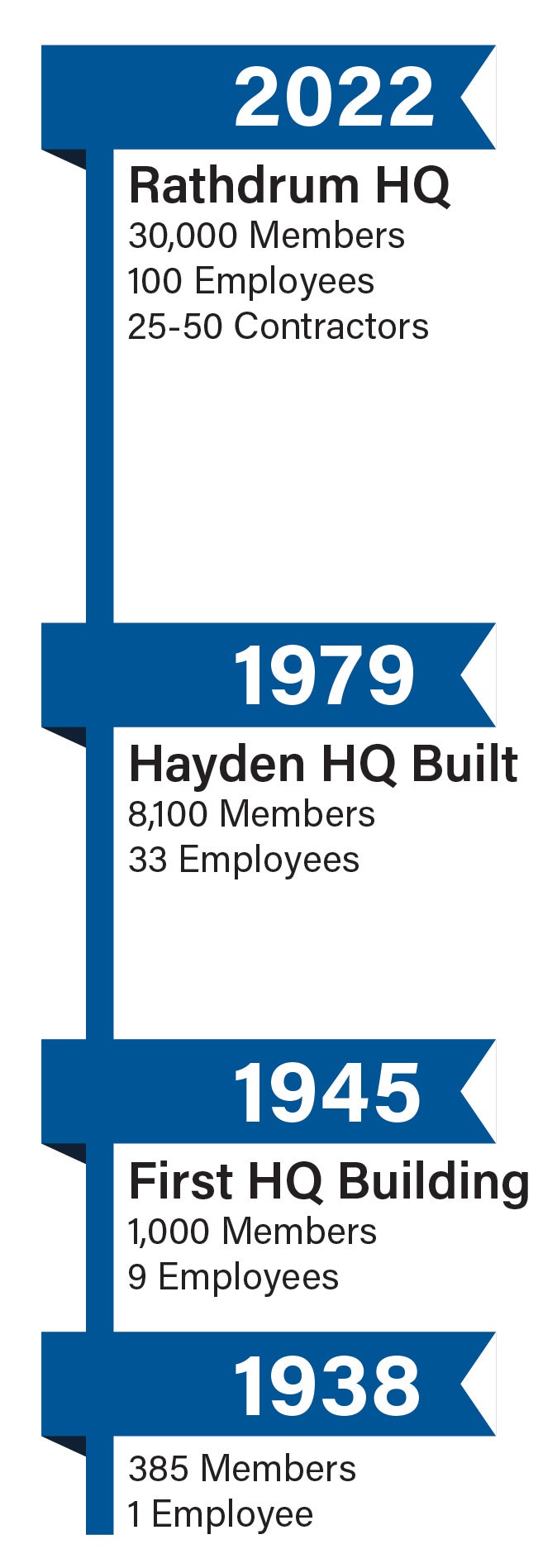 In the early 1970s we had 18 employees and approximately 4,000 meters on our system. Today we have over 100 employees and 30,000 meters on our system. We have added 18 employees to our workforce just since 2015. Looking ahead, we expect to add an additional 12-15 employees over the next five years as our membership and community continue to grow.
In the early 1970s we had 18 employees and approximately 4,000 meters on our system. Today we have over 100 employees and 30,000 meters on our system. We have added 18 employees to our workforce just since 2015. Looking ahead, we expect to add an additional 12-15 employees over the next five years as our membership and community continue to grow.
In 2020, we engaged a third-party consultant to provide an independent evaluation of the cooperative’s facility needs and use. The consultant specializes in headquarter facility planning studies and planning and design for electric cooperatives around the country. They completed a comprehensive site, facility and needs assessment with these goals in mind:
- Protect expensive material, vehicles and equipment
- Improve operational efficiency
- Accommodate future growth
- Provide facilities that allow for adequate emergency operations response
- Improve and foster safety and security
- Foster a collaborative and high performing employee culture
This study was commissioned in part to validate the findings of a similar study that had been completed the year prior. The construction of a new facility represents a considerable undertaking for the cooperative. We wanted to ensure all alternatives were considered and our decisions were fully informed. Crucially, both studies arrived at the same conclusions.
The results revealed that our previous facilities were inadequate for current and future space needs. In fact, our Hayden facilities only met approximately 54% of our anticipated square footage needs based on our historic growth. The previous buildings would require moderate-to-significant modifications to meet our needs and building code requirements. While repairs/replacements would have improved the physical conditions, energy efficiency and overall layout, items like traffic flow and operational efficiencies could not be overcome at our former location.
The consultant presented five options to KEC’s board of directors based on the needs assessment. Each option identified which needs would be addressed. The options are outlined below and ranged from addressing only immediate facility deficits to finding a new site and constructing a new facility.
- Remain on Hayden site and address immediate facility needs.
- Remain on Hayden site and renovate it to suit future needs to the extent possible, given size and location constraints.
- Purchase a five-acre site directly across Dakota Ave. from our main Hayden building and construct a new engineering and operations center on that site, along with major renovations of our existing facilities. The site sold, in fact, prior to the completion of our assessment, rendering this option less likely.
- Construction of a new engineering and operations center at a new location while maintaining our administrative presence at our Hayden location. In this scenario, we could lease out the space currently occupied by our engineering and operations departments to another tenant. The new facility could be constructed in such a way as to accommodate the alternative below should that be needed in the future.
- Construction of a new headquarters facility at a new location. In this scenario, our current headquarters would be sold or leased to another tenant.
The KEC board of directors ultimately eliminated the first three options due to their limitations and further evaluated options 4 and 5.
We successfully negotiated a sales agreement with Kootenai County on our Hayden headquarters facility which was approved by both the KEC board of directors and Kootenai County commissioners. The County purchased our headquarters for $4.72 million. As part of the deal, KEC had the right to continue operating from it rent-free for the next three years. The value of the transaction was fair for both parties, making it a good deal for our members and for the residents of Kootenai County. Crucially, the sale of our headquarters eliminated risk for the cooperative. Focus could then shift to the construction of a new headquarters.
Construction of a new headquarters began in early spring of 2022. KEC was able to occupy the new headquarters in late October 2023.The process was not unreasonably rushed. Ensuring our future facilities were well planned and constructed efficiently was a primary goal.
This investment in our future was not inexpensive. It represents an investment of between $42 to $46 million. To ensure our headquarters was not overbuilt, the initial construction was planned to accommodate about ten years of new growth. The facility is laid out so that growth beyond that can be accommodated by expanding administrative office space, warehousing, fleet parking and our materials laydown yard as future growth occurs.
Since this was a capital investment, the cost of the headquarters will be depreciated over the life of the building. Our Hayden headquarters served our needs for more than 40 years and we expect our new facility to have a similar lifespan. The good news is interest rates were historically low and the financing for the facility will be paid back over a 30-year period. This allows for members today and into the future to contribute to the benefit they receive.
This is a question that is on the cooperative’s mind with every expenditure it makes. To answer that question, KEC maintains a 10-year financial forecast. This forecast estimates the additional revenue produced by growth and the additional costs incurred in serving it. While the investment in a new headquarters is considerable, there are others of similar scale to consider. Among them are the system improvements and maintenance needed to ensure our members have access to the power they desire to use. All factors considered, KEC forecasts that future rate increases will not exceed the historical rate of inflation. As an electric cooperative operating on a not-for-profit basis, ensuring our rates are as low as possible remains a core and central priority. That will never change.
We did. While some employees could have worked effectively from home, most could not. Doing so requires access to high-speed internet and a dedicated place within their home where they can work uninterrupted. However, the greatest factor that compelled our need for a new headquarters had to do with the trucks, materials and equipment used by our linemen. Storing those trucks and warehousing the materials needed to provide our members exceptional service could not be done elsewhere.
